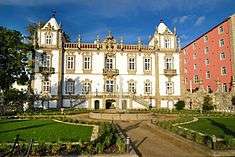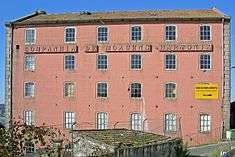Palace of Freixo
| Palace of Freixo (Palácio de Freixo) | |
| Palace (Palácio) | |
 A view of the palatial structure of the residence of Marquesses of Freixo | |
| Official name: Palácio de Freixo | |
| Country | |
|---|---|
| Region | Norte |
| Subregion | Grande Porto |
| District | Porto |
| Municipality | Porto |
| Location | Campanhã |
| - coordinates | PT 41°8′33″N 8°34′29″W / 41.14250°N 8.57472°WCoordinates: PT 41°8′33″N 8°34′29″W / 41.14250°N 8.57472°W |
| Architects | David Sinclair, Jaime Morais, Nicolau Nasoni |
| Style | Baroque |
| Materials | Granite, Quicklime |
| Owner | Portugal |
| For public | Private |
| Visitation | Closed |
| Easiest access | Estrada Nacional E.N.108 |
| Management | Instituto Gestão do Patrimonio Arquitectónico e Arqueológico |
| Status | National Monument Monumento Nacional |
| Listing | Decree 16 June 1910, Diário do Governo 136 (23 June 1910); Special Protection Zone (ZEP), Dispatch, Diário do Governo, Série 2, 79 (6 April 1949) |
| Wikimedia Commons: Palácio de Freixo | |
The Palace of Freixo (Portuguese: Palácio de Freixo) is a former-residence in the civil parish of Campanhã, in the northern Portuguese city of Porto.
History
.jpg)


.jpg)
The residence was order constructed in the middle of the 18th century, by Nicolau Nasoni, by orders of the Canon Jerónimo de Távora, a man of great wealth, from a noble family of Cernaches.[1]
At the end of the 18th century, the Viscounts of Azurara purchased the residence, after its original sale to the merchant António Afonso, who had constructed alongside the building a soap factory.[1]
In 1850, the palace and estate was sold to António Afonso Velado, who by 1866 had received the title of Baron of Freixo.[1] By 1870, his success had put him in line for the title of Viscount of Freixo, resulting in his need to substitute the Tavira coat-of-arms on the old building and complete renovations.[1] Part of the changes included large murals on mortar within the structure, and attributable to this period.[1] The coat-of-arms of the Tavora decorated many parts of the building, but were later destroyed by the Marquis of Pombal, following the attempted Regicide of King D. Joseph.[1] The gardens, a Nasonian inspiration, were divided by architectonic alleys of with balustrades and small villages of allegorical sculptures, while along the river there ran a balcony.[1]
In the 20th century, an industrial purchased the building, installing in the gardens a milling factory, and later a 45 metres (148 ft) silo. Within the palace this entrepreneur established his administration in building.[1] By 1870, tile and ceramics were installed in the building, ostensibly as a provisional solution to hide damage to the building.[1]
Following a 1909 flood, the varanda was destroyed.[1]
But, it was only in 1947 that recuperation of the building was undertaken, under the leadership of its occupant Companhia de Moagens Harmonia (Harmony Milling Company), of the União Fabril.[1] A new silo was also constructed within the next few years to increase production at site.[1]
In 1983, by decree (344-A/83), it was determined that the SEOP would begin the acquisition of the property: the process was completed on 30 November 1984, by the Ministério do Trabalho (Ministry of Work).[1] A limited public tender was executed in 1985 to complete emergency repairs, but on 6 June 1985 there was a fire.[1] As a consequence, the remain slate floors were removed from the site, and emergency public works were begun. Recuperation of the tile, facades and frameworks, cleaning of the gardens and enclosures.[1]
The palace was recuperated under terms of project Metropólis, where the government contributed 10 million contos. The project, under the direction of architect Fernando Távora, was polemic, since it envisioned the transfer of the old installations of the Fábrica Harmonia below the palace, where they would be reconstructed.[1] The project was denied by the local council in January 1998, when the architect was instructed to reformulate the plan.[1] Other parts of the project, that included the creation of a small marina, the re-routing of a marginal roadway next to Freixo and the construction of a new building (to commemorate Vasco da Gama's trip to Brazil and provide a venue for the celebrations marking the Age of Discoveries), to shelter the Press Museum and other tenants, remained.[1]
In November 2005, approval was provided by the municipality to begin the installation of a hostel in the palace and milling buildings. This development fell under the operation of Grupo Pestana, under the concession of Pousadas de Portugal.[1] The protocol between Pestana and the municipal council of Porto was signed in March 2006 to establish a Pousasda Histórica model, under the projection of David Sinclair, which included the connection of the palace to the historic milling factory.[1] The resulting project transformed the palace spaces into common areas and the milling factory into bedrooms.[1]
In December 2006, the IPPAR approved the conversion project of ENATUR, but only in October 2009, was an official inauguration held for the Freixo Palace Hotel, championed by architect David Sinclair and interior designer Jaime Morais.[1]
Architecture
.jpg)
.jpg)
The palace and company factory are located in an isolate location along the riverway, built over an accentuated slope separated by gardens.[1]
The rectangular palace includes towers subtlely taller then the main building, and covered by pyramidal merlons and encircled by smaller pinnacles. Uniting the towers, with decorative flourishes, is a cornice.[1]
Each facade of the palace have unique traits, constructed on three-floors.[1] In the south, the building has two-and-a-half registers; the western facade has two floors; and the east appears to include three-stories.[1] In the western facade is a chamfered niche, with windows above it, with the central surmounted by garlands and scrolls, similar to those over the palace portico.[1] Along the southern facade, overlooking the river, is a state room consisting of three balconies with balustrades, recessed central window and projected staircase.[1] The imponent eastern facade includes a grande staircase, but with recessed central zone girded by the towers, and decorated by balustrades and ornamented platforms (festooned by wrapped garlands and dolphins).[1] The doors in the central corp are decorated with cornerstones that terminate in an interrupted frontispiece, surmounted by the coat-of-arms of the Baron of Freixo.[1]
In the interior, as mural paintings in blues, browns, ochres, reds and rose, framed by rectangular moulding.[1] Most of the interior has been changed and reformulated, and do not retain the original interior design of the period of construction.[1]
In the western garden is a belvedere, typical of the Italianate gardens of the period, which is accessible from the eastern terrain.[1] In the east is a hemicycle, flanked by two small pavilions and decorated with sculpted drums, helms, shields and flags, cannons and balls.[1]
References
Notes
- 1 2 3 4 5 6 7 8 9 10 11 12 13 14 15 16 17 18 19 20 21 22 23 24 25 26 27 28 29 30 31 32 33 34 Sereno, Isabel; Noé, Paula (1998), SIPA, ed., Palácio de Freixo (IPA.00005458/PT011312030008) (in Portuguese), Lisbon, Portugal: SIPA – Sistema de Informação para o Património Arquitectónico, retrieved 13 November 2016
Sources
- Passos, Carlos (1935), Guia Histórico e Artístico do Porto (in Portuguese)
- Revista Panorama (in Portuguese) (5/6), 1941
- Palácios e Solares Portugueses, Encyclopédia pela Imagem (in Portuguese) (2)
- Santos, Reynaldo dos, Historia de Arte em Portugal (in Portuguese), III
- Silva, António Lambert Pereira da, Nobres Casas de Portugal (in Portuguese), I
- Araújo, Elísio de (1962), A Arte Paisagista e Arte dos Jardins (in Portuguese), Lisbon, Porutgal
- Azevedo, Carlos de (1969), Solares Portugueses (in Portuguese), Lisbon, Porutgal
- Borges, Nelson Correia (1986), História da Arte em Portugal. Do Barroco ao Rococó (in Portuguese), 9, Lisbon, Porutgal
- Quaresma, Maria Clementina de Carvalho (1995), Inventário Artístico de Portugal. Cidade do Porto (in Portuguese), Lisbon, Porutgal
- Luz, Carla Sofia (24 December 2006), Porto - IPPAR dá aval à pousada no Palácio do Freixo in Jornal de Noticias (in Portuguese)